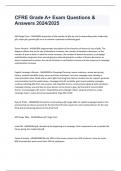CFRE Grade A+ Exam Questions &
Answers 2024/2025
Gift Range Chart - ANSWERSA projection of the number of gifts by size (in descending order: leadership
gift, major gift, general gift) so as to achieve a particular fundraising goal.
Donor Pyramid - ANSWERSA diagrammatic description of the hierarchy of donors by size of gifts. The
diagram reflects that as the size of donations increases, the number of donations decreases; as the
number of years a donor is asked to renew increases, the number of donors decreases; as campaign
sophistication progresses from annual giving to planned giving the number of donors decreases; as
donor involvement increases, the size of the donor's contribution increase and the response to campaign
sophistication increases.
Capital Campaign Lifecycle - ANSWERSPre-Campaign Planning: assess readiness, review past giving
history, conduct feasibility study, secure and train volunteers, test your campaign case, develop a
communications plan. Quiet phase: solicit gifts from long time donors, finalize case for support, generate
communication tools for public phase. Campaign kick off: set dollar goal, launch publicly campaign,
continue soliciting gifts from new sources, tell impactful stories, communicate regularly with volunteers.
Campaign Closing: use end date to move donors on the fence to give, do final ask of uncommitted
donors, end campaign with events. Stewardship and campaign impact: steward all donors, create
campaign report. assess processes (evaluation). Page 246 of AEF
Rule of Thirds - ANSWERSA formula for constructing a gift range table for capital campaign based on the
premise that ten donors account for the first third of funds raised, the next hundred donors for the next
third and all remaining donors for the final third.
Gift Range Table - ANSWERSsee gift range chart
Lead Gift - ANSWERSA gift, donated at the beginning of a campaign, that is expected to set a standard for
future giving. See Leadership gift.
Pareto Principle - ANSWERS80/20 rule. 80% of the money comes from 20% of donors. Same for work,
80% of productive work comes from 20% of employees.
, What is required to run a successful Capital Campaign? - ANSWERSInternal? External? Staff, board,
volunteers, CASE, donor base (internal), cultivation, etc.
Annual Report - ANSWERSA yearly report of the financial and program status of an organization or
institution.
Donor Retention - ANSWERSDonor retention entails engaging existing donors so that they continue to
give to the organization each year. By doing so, you have retained that donor. Retention efforts include
encouraging a donor to give on a set schedule and interacting with them regularly so that they feel
valued.
LYBUNT - ANSWERSLYBUNT stands for Last Year But Unfortunately Not This year, meaning the donor
supported your organization during the last fiscal year but did not return to donate again this year.
SYBUNT stands for Some Year But Unfortunately Not This year.
Social Styles (Joyaux's definition) - ANSWERSDriver: focus on results, take charge, make quick decisions,
like challenges. Analytical: focused on fact and logic, act when payoff is clear, careful not to commit too
quickly. Amiable: cooperate to gain agreement, provide support and communicate trust and confidence.
Expressive: create excitement and involvement, share ideas, and enthusiasm=and, motivate , inspire and
persuade.
Advance Gift - ANSWERSA donation, often from a trustee or director of an organization, that
demonstrates a commitment to a campaign and provides momentum at the outset before external
solicitations are undertaken.
Asset - ANSWERSSomething that has value or an advantage; an item of value such as real estate, cash a
security or patent.
Brand for a nonprofit - ANSWERSAn impression of a product in the minds of current or prospective
consumers that is typically created by its manufacturer to convince users that this product is superior to
other brands of the same product, although it may be technically identical to other brands.




